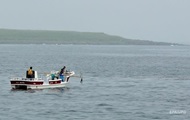NASA trying to make music from sea color image using their Earth observation satellite. Two scientists from the Goddard Space Flight Center, Ryan Vandermeulen and his brother, Jon Vandermeulen, are leading the project.
Launching the official NASA website, the project lasted 18 months. Scientists at NASA used ocean images from the Rio de la Plata coast to the Indian Ocean. The color is then combined with musical notes.
The goal of this project is to give viewers a new experience in ocean imaging that scientists at Goddard learn every day. It is hoped that the audience will understand the complexity of the large and constantly changing ecosystem.
“We want to tell stories to appreciate the connection of the oceans Earth we go through the experience of sonic sounds. We use music because it’s very entertaining and dynamic and connects us across different backgrounds,” says Vandermeulen.
Vandermeulen’s journey starts from Rio de la Plata. Vandermeulen said he was amazed by the complexity of the colors on the coast and wondered what kind of sound the colors would make.
“I started extracting data from satellite imagery. I saw patterns of red, green, blue. Obviously, the colors weren’t going in the same direction. There was something there,” he said.
To use the data, it scales each color channel and assigns musical notes to express changes in the image. “The data itself can be heard as it is. The variations create a natural palette for the ear,” he said.
Bering Sea
Once in Rio de La Plata, Vandermeulen continued his project to the Bering Sea. In the sea which is part of the Pacific Ocean, Vandermeulen is assisted by his younger brother, Jon.
He then created a program that transferred the data to musical notes. Then, he rebuilt the program so that the translated data could be imported into a voice processing application.
For Jon, that app is GarageBand. Through their site, spektune.com, anyone can import data to make music for free.
The program then composes music for each color of the Bering Sea. Just like on the coast of Rio de La Plata, Jon and Ryan focused on data from the colors red, green, and blue.
“It’s a really honest sound experience. Three simple instruments chime in and you can hear when one goes up, the other goes down. You can really hear the harmonies,” says Jon.
Australian Coral Sea
Ryan and Jon then continue their journey to the Coral Sea off the Australian coast. Here, Ryan and Jon focus on a year’s worth of data collected from the Aqua-Modis satellite to create melodies.
The data was extracted from the 32-day average image of chlorophyll a –a specific form of chlorophyll commonly used in photosynthesis– . A total of 48 images collected depict the four seasons in Australia.
Indian Ocean
Ryan and Jon’s final stop is in the Indian Ocean. They both judged the color of the Ocean to be unique. “Like creamer in coffee,” said Jon.
They then collected data consisting of satellite imagery for 31 days. Ryan and Jon also combined the wavelengths of light reflected on the ocean surface. “Really special,” he said.
Jon himself wanted to try something different. So, he made a way to offset each data. From that process, the Indian Ocean produces melodies like waltz music.
Various Disciplines
According to the official website, Goddard Space Flight Center is located in Maryland. Although part of NASA, the Goddard Space Center collects data that scientists around the world can use from a variety of disciplines.
There are more than 50 planes belonging to the Goddard Space Center exploring the Earth and the Solar System. The Hubble Telescope is also housed at the Goddard Space Center along with several Mars probes such as Curiosity and MAVEN.
(lth)
–


